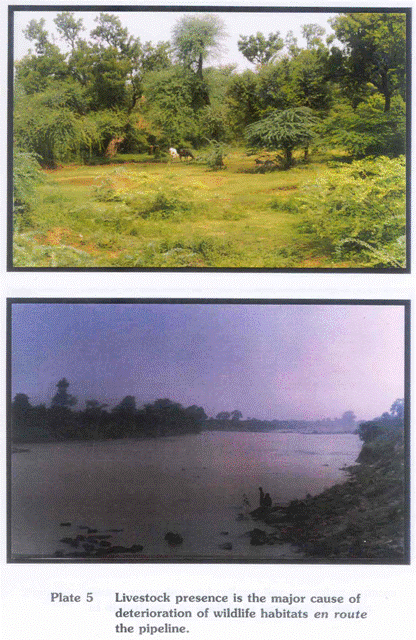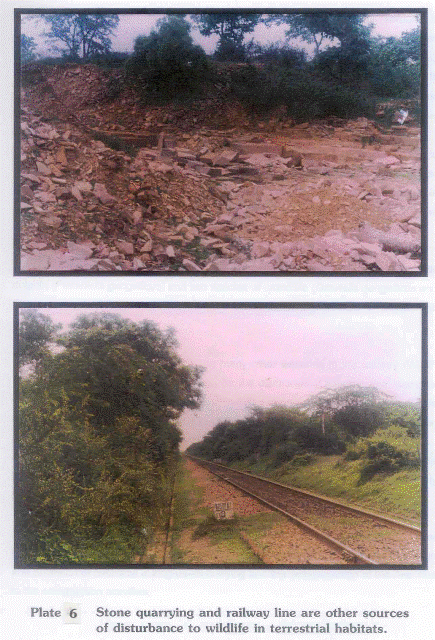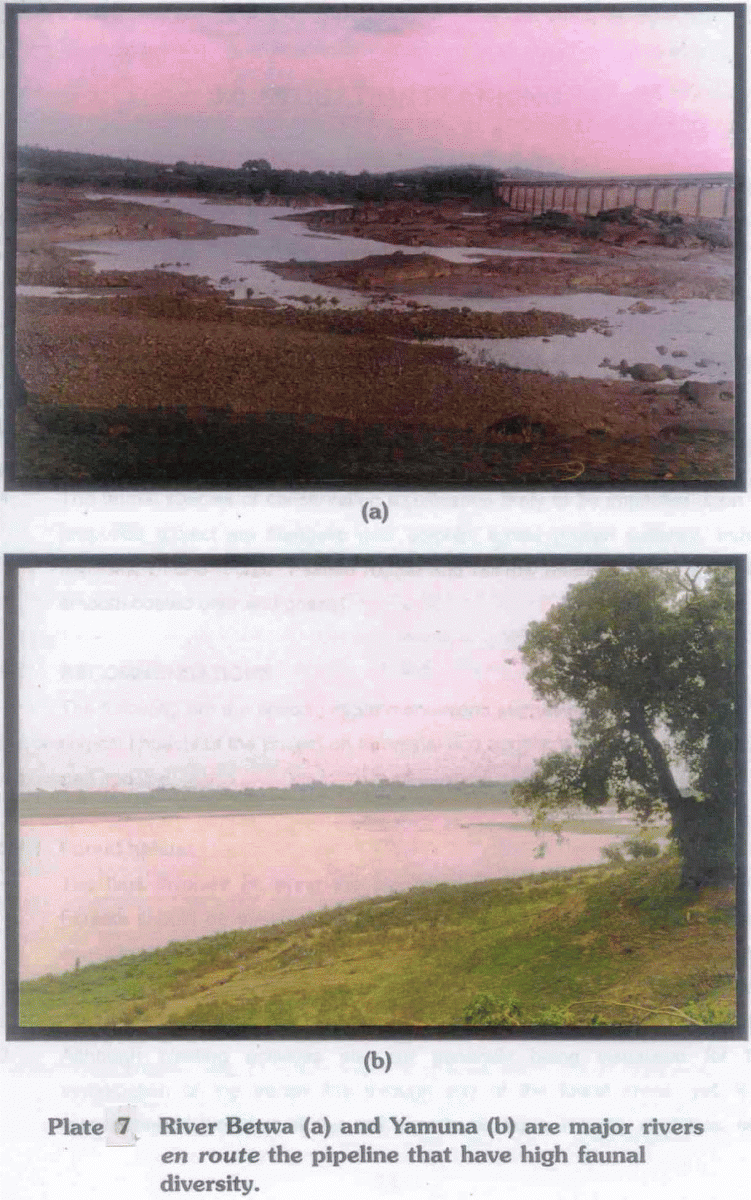Impact prediction
|
Characterisation of the existing environment, definition of project activities, and understanding of ecosystem function lay the foundation for the prediction of future condition relative to baseline condition. Impact prediction then becomes essentially an exercise to forecast the impacts of proposed developmental projects by linking project actions to changes in the baseline environmental characteristics. The major activities anticipated under the BJK Pipeline project that are likely to bring about alteration in the ecological and biological characteristics of the major ecosystems identified in the pipeline corridor are: i) removal of vegetation in the acquired RoU (Right of Use). ii) surface excavation. iii) trenching and subsequent filling. iv) diversion of water flow from aquatic body. v) blasting and drilling. vi) creation of storage facility. vii) construction of access road. viii) camping of staff and labour. ix) transportation of manpower, equipment and material. The ecological impacts of the proposed project would be largely influenced by the following factors- i) length of pipeline alignment through the forest route. ii) existing status of floral and faunal values. iii) existing status of habitat quality. iv) existing levels and sources of ecological disturbances. v) landuse within the proposed pipeline corridor. vi) physio-chemical characteristics of the wetland. vii) choice of technology adopted for pipeline laying. viii) time involved in laying of pipeline through critical habitats. Specific impacts on habitat categories, identified during this study are given as under: 5.1 IMPACTS ON TERRESTRIAL HABITATS The 361 km (approx.) long proposed Bina-Jhansi-Kanpur pipeline will traverse through the reserved forest for a total length of 13.5 km. The direct impacts of the project on the forest can result from the (i) removal of vegetation (trees, shrubs, herbs and grasses) leading to reduction in quantitative parameters of the habitat i.e. food, cover and shelter for the existing faunal species (ii) blasting activity and associated disturbances during trenching through rocky corridors leading to modifications in the habitat (iii) disturbances associated with transportation of labour, construction material and equipment and the creation of new access to habitats resulting in their fragmentation. (iv) subsequent disturbances in the pipeline tract during the maintenance and monitoring phase of the project. 5.1.1 Impacts on Dewal Reserved Forest The proposed pipeline would traverse through Dewal Reserved Forest for a distance of 3 km. This forest in Bina Division represents the typical Central Indian dry deciduous teak forest intermixed with dry deciduous mixed forests. These stratified forests with well defined top, middle and lower layers of vegetation are ideal habitats for most species reported to occur in such forests in Central India. However, on account of intense grazing pressures these forests have become highly degraded. The increase in proportion of unpalatable, thorny plant species have replaced the original vegetation in most of the intensively grazed areas. The existing status of the wildlife is fairly lowered due to intense resource competition enhanced by increased livestock dependence on these forests. The proposed alignment of pipeline for 3 km within this forest will therefore not result in significant and irreversible impacts. 5.1.2 Impacts on Dhojri and Chandpur Reserved Forests Of the total length of 13.5 km of pipeline through forested tracts, the proposed pipeline will traverse the Dhojri and Chandpur RFs for the longest distance of 6.9 km through a single forest patch. The baseline studies conducted to evaluate the existing status of these forests as wildlife habitats establish that these forests have been a home to a large number of wild species of great conservation significance including the carnivores like leopard, jungle cat, wolf and several species of ungulates (chinkara, spotted deer and nilgai). Over the years, these forests have also become open to disturbances associated with timber and fuelwood collection, over grazing and large scale quarrying for red sand stone (Plate 5 & 6). The proposed pipeline through this forest is actually aligned through an area currently under mining for sand stone. Most of the animals reported from this area have insignificant numbers as no direct and indirect evidence could be collected. The only evidences that could be collected were those of chinkara and nilgai, the species which are characteristic of degraded areas.
Although the alignment of proposed pipeline through these forests is not going to significantly impact upon the wildlife values of these habitats, yet it is important to prevent further reduction in the size and quality of areas under wildlife habitat to arrest the decline in wildlife populations and diversity in different wilderness tracts of the country. It is therefore extremely important to protect and promote the wildlife potential of forest habitats that are even degraded. 5.1.3 Impacts on Kalpi and Alampur Reserved Forests The proposed pipeline is aligned for a distance of 3.1 km through these two Reserved Forests. The two patches of the Reserved Forest are adjacent to each other. Their contiguity is broken only by the presence of forest road. These forests characterised by thorny species are highly degraded patches of vegetation. Their proximity to the main road connecting Orai to Kanpur and the presence of railway line within the forests have both contributed in the reduced significance of these forests as potential wildlife habitats (Plate 5). The presence of wildlife species reported from these areas earlier could not be confirmed during the survey. The proposed pipeline is not expected to further impact upon the degraded status of these forests. The proposed alignment of Bina-Jhansi-Kanpur pipeline alone does not involve a substantial landtake, nor will the pipeline traverse the areas supporting significant diversity or critical habitats, yet it would lead to some temporary modifications in the structure, and functions of the terrestrial ecosystems. The impacts of temporary or reversible nature can be significantly reduced by evolving strategies for preventive mitigation. 5.2 IMPACTS ON WETLANDS The ecological significance of all wetlands is realised in their functions as habitats for migration (diurnal, nocturnal and seasonal) of aquatic animals, habitats for nesting and reproduction of terrestrial and aquatic biota and as the critical habitats for rare and endangered species. It is for this reason it is crucial to identify the impacts of proposed development on wetlands en route the pipeline. Having established the range of activities associated with the laying of pipeline and the factors that are likely to influence the magnitude and significance of the impacts, the results of evaluation of the ecological impacts of proposed BJK Pipeline are as under: All the six rivers en route the pipeline corridor have been recognised as habitats for more than one faunal group (Table 8). Table 8. Wildlife values and conservation significance of major wetlands en route.
The baseline studies conducted to determine the status of Icthyofauna in different wetlands (Table 7) establish that all these wetlands have a fairly diverse Icthyofauna. Based on the number of fish species confirmed in Narain (16 spp.), Pahuj (22 spp.), Betwa (26 spp.), Yamuna (23 spp.), Sengar (22 spp.) and Rind (16 spp.) it can be established that almost all wetlands have a potential to support diverse fish fauna. Occurrence of turtles in all these wetlands establish the suitability of importance of these habitats for supporting chelonian species. Presence of endangered species of turtle - Lissemys punctata in Pahuj, Rind and Yamuna and Asperetes gangeticus in Betwa and Yamuna and Asperetes hurum, Kachuga kachuga and Kachuga dhongoka in Yamuna have greatly enhanced the conservation value of these wetlands. Presence of Smooth coated otter (Lutra perspicillata) in Betwa and Gangetic dolphin (Platanista gangeticus) and two species of crocodile (Gravialis gangeticus and Crocodylus palustris) further enhance the conservation significance of Betwa and Yamuna. The values of these wetlands like many other wetlands in the country (WWF, 1992) have been greatly impacted upon by the discharge of sewage and industrial effluents, agricultural run off, bank cultivation, sand mining and over fishing. In Table 8, which presents the faunal status of different wetlands, these factors have been considered in establishing the conservation significance of each of these wetlands. River Yamuna and Betwa are the two wetlands that command significance as wetland habitats (Plate 7). It is for this reason that impacts of the pipeline alignment are likely to be more significant on Yamuna and Betwa.
The ecology of the turtles and dolphin habitats in Yamuna and turtles and otter habitats in Betwa are likely to be impacted by changes in hydrology due to alteration and diversion of river flow during pipeline laying and the sedimentation of the river due to the construction activities. Since the future survival of all endangered species is dependent on the protection ensured to all its habitats both within and outside the protected area network of the country, careful planning and timing of activities and utmost care during the construction phase should be the essential consideration in the planning and implementation of a pipeline project. Specific recommendations are being provided in subsequent section to mitigate some of the impacts on wetland values/habitats. |
||||||||||||||||||||||||||||||||||||||||||||||||||||||||||||||||
Last Updated: October 7, 2015












